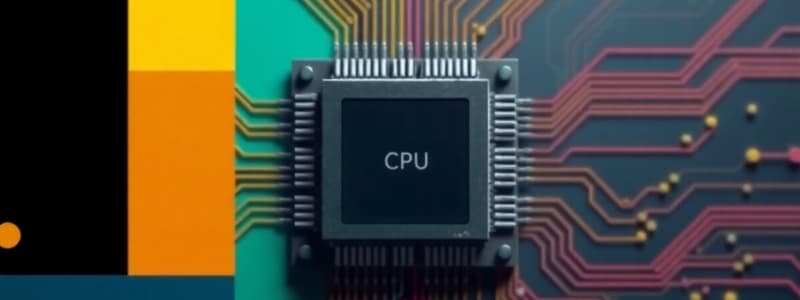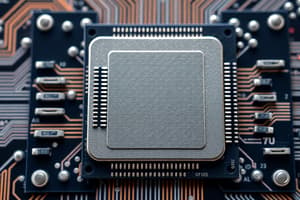Podcast
Questions and Answers
Which of the following best describes the primary role of the CPU within a computer system?
Which of the following best describes the primary role of the CPU within a computer system?
- Storing data and instructions for later use.
- Managing the flow of data between different components.
- Executing instructions to perform computations and control the system. (correct)
- Providing long-term storage for files and applications.
During the instruction execution cycle, what is the primary function of the 'fetch' stage?
During the instruction execution cycle, what is the primary function of the 'fetch' stage?
- Decoding the instruction to determine the operation to be performed.
- Storing the result of the instruction in memory.
- Retrieving the instruction from memory. (correct)
- Executing the instruction to produce a result.
Which of the following bus structures is most likely to result in bottlenecks during high data transfer rates due to resource sharing?
Which of the following bus structures is most likely to result in bottlenecks during high data transfer rates due to resource sharing?
- Hierarchical bus architecture.
- Point-to-point connection.
- Multi-bus architecture.
- Single-bus architecture. (correct)
If a processor's clock rate is increased without any other architectural improvements, what is the MOST likely outcome regarding CPU execution time?
If a processor's clock rate is increased without any other architectural improvements, what is the MOST likely outcome regarding CPU execution time?
When performing subtraction with signed numbers in a computer, what is the significance of using 2's complement?
When performing subtraction with signed numbers in a computer, what is the significance of using 2's complement?
Flashcards
Functional Units
Functional Units
The components of a computer system, including the CPU, memory, and I/O (Input/Output) units.
Instruction Execution Cycle
Instruction Execution Cycle
The sequence a CPU follows to execute an instruction, which includes fetching the instruction, decoding it, and executing it.
Bus Structures
Bus Structures
Different organizational structures for buses within a computer system, such as single-bus, multi-bus, and hierarchical buses.
Factors of Performance
Factors of Performance
Signup and view all the flashcards
Booth’s Algorithm
Booth’s Algorithm
Signup and view all the flashcards
Study Notes
- Computer system components consist of CPU, memory, and I/O.
- The instruction execution cycle involves fetching and decoding instructions.
- Single-bus, multi-bus, and hierarchical buses are types of bus structures.
- CPU execution time, CPI, clock cycles, and benchmarking affect performance
- 8085 and 8086 are example architectures with instruction sets and addressing modes
Modern Architectures
- ARM Cortex, Intel Core, and AMD Ryzen are examples of modern architectures.
- Instruction sets, formats, and addressing modes are key architectural elements.
- Binary and hexadecimal number systems are used in computer systems.
Integer Arithmetic
- Addition and subtraction can be performed with signed numbers.
- Carry look-ahead addition is used for fast addition.
Multiplication and Division
- Booth’s algorithm is a multiplication algorithm.
- Restoring and non-restoring methods are used for division.
Floating Point Arithmetic
- IEEE 754 is a standard for floating point arithmetic.
- Single and double precision are types of floating point operations.
Fundamental Concepts of Processing
- Instruction execution involves fetch, decode, and execute stages.
- Processor design and microarchitecture are key aspects of processing.
Studying That Suits You
Use AI to generate personalized quizzes and flashcards to suit your learning preferences.




